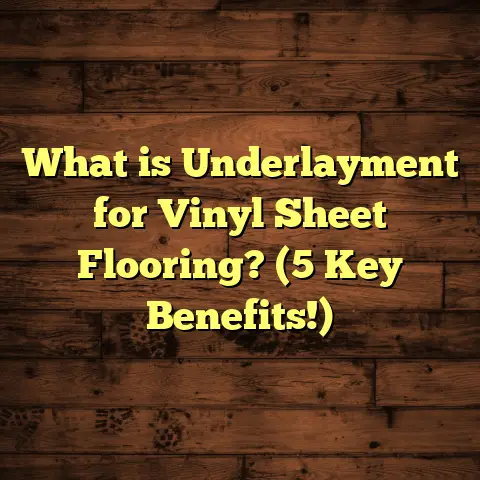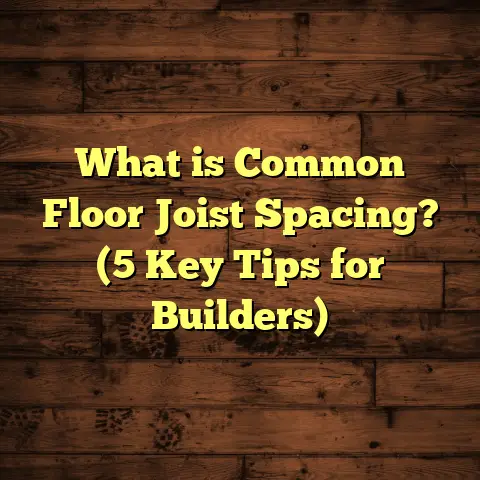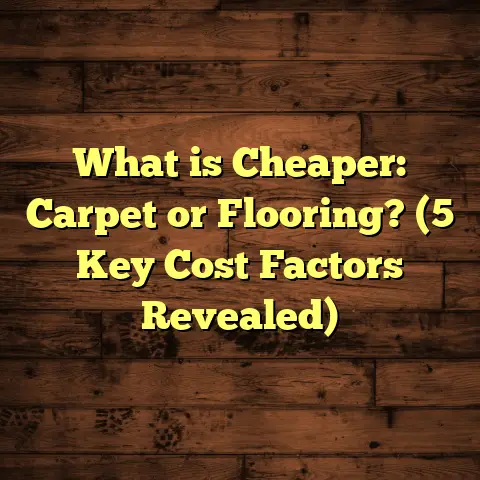What Is a Standard Per Square Foot Charge for Floor Replacement? (5 Key Factors to Consider)
I want to share something that might surprise you—figuring out what it really costs per square foot
to replace your floors isn’t as straightforward as most people think. When I first started
working in flooring, I assumed there was a simple answer: just a flat rate per square foot. But
boy, was I wrong. The price can swing drastically, and it depends on several factors that most
folks don’t realize until the bill comes in.
It’s almost like trying to guess the price of a meal at a restaurant just by looking at the menu without knowing if you’re ordering appetizers, drinks, or dessert. Floored isn’t just about materials—it’s about labor, prep work, location, and hidden challenges.
Over the years, I’ve learned firsthand how these variables shape the final cost. Sometimes homeowners are thrilled with a deal; other times, they’re blindsided by unexpected expenses. I want to guide you through the maze so you can approach your flooring project with confidence.
What Is a Standard Per Square Foot Charge for Floor Replacement?
Let’s break it down. When I say “standard per square foot charge,” I’m talking about the average
cost charged by contractors or flooring companies to remove old flooring and install new flooring
measured by every square foot of surface area. It’s a common pricing method because it helps
homeowners get a rough idea of the budget they need for their project.
But here’s the catch: there’s no one-size-fits-all number. The “standard” rate can vary based on
where you live, what type of flooring you want, how complex the installation is, and who does
the work. For example, replacing carpet with carpet might cost less per square foot than replacing
tile with hardwood.
When I started taking on flooring jobs, I noticed many customers were shocked to learn how much
these prices fluctuate. That’s why I always recommend understanding the details behind the number,
not just focusing on the price tag alone.
Why Does the Cost Vary So Much?
Think about it like this — if you’re buying a car, the brand, model, and features hugely change the price.
Flooring is no different. The materials alone can range from affordable vinyl at around $2 per square foot
to exotic hardwoods or custom tile that can shoot up to $20 or more per square foot.
On top of material costs, labor charges can differ widely depending on the skill level required and local
wages. Some jobs take longer because of tricky room shapes or subfloor repairs, pushing up costs.
With all these variables, trying to find a “standard” number feels a bit like chasing a moving target.
5 Key Factors That Affect Your Per Square Foot Flooring Charge
I want to walk you through the main reasons why prices vary so much. When you’re ready to replace your floors,
these are the things I always look at and explain to my customers.
1. Type of Flooring Material
This one’s obvious but worth spelling out. Materials make up a big chunk of the cost. Here’s a quick overview:
- Vinyl: $2 – $5 per sq ft
- Laminate: $3 – $7 per sq ft
- Carpet: $3 – $6 per sq ft
- Ceramic or Porcelain Tile: $5 – $15 per sq ft
- Engineered Hardwood: $6 – $12 per sq ft
- Solid Hardwood: $8 – $15+ per sq ft
I’ve worked on some jobs where customers wanted reclaimed hardwood — that was on the higher end
because sourcing and installing it took special care.
In one case, a client chose luxury vinyl plank (LVP) for its durability and cost-effectiveness. Their total
price was around $4.50 per sq ft installed, including removal of old flooring. Another client wanted maple
hardwood, which pushed their price close to $14 per sq ft due to material costs alone.
Digging Deeper Into Materials
Material choice doesn’t just affect price but also longevity and maintenance costs down the line.
For example, vinyl and laminate are often praised for being budget-friendly and easy to maintain—great for busy families or rental properties. But they typically don’t add as much value to your home as hardwood or tile might.
Hardwood floors have that timeless appeal and can be refinished multiple times over their lifespan,
which sometimes makes their higher upfront cost worth it in my book. However, they’re sensitive to moisture and scratches, so not every environment suits them.
Tile is incredibly durable and comes in endless styles but requires more careful installation and grout maintenance.
Personal Story: When Material Choice Made All the Difference
I remember a couple who wanted hardwood but had three dogs and two kids running around constantly. We discussed how hardwood might scratch easily under those conditions. Instead, we looked at high-quality luxury vinyl plank that mimicked hardwood’s look but offered superior resistance to wear and moisture.
They ended up saving about 30% compared to hardwood, spent less on maintenance over time, and still achieved a beautiful finish that suited their lifestyle.
2. Labor Costs and Installation Complexity
Labor can be surprisingly variable. In cities with higher wages and living costs, expect labor charges to be
20%-50% higher than in rural areas.
But labor isn’t just about hourly rates. The complexity of your floor plan matters. Rooms with lots of angles,
stairs, or odd shapes require more precision and time. This can easily add $1 to $3 per square foot in labor fees.
For example, I once installed tile in a kitchen with a diagonal pattern — that took extra cutting and layout time.
The labor charge was almost double compared to a simple rectangular room.
Labor Types: What Are You Paying For?
- Removal labor: Getting rid of old flooring can be quick or lengthy depending on what’s there.
- Prep work: Cleaning, leveling, and repairing subfloors.
- Installation labor: Skilled work varies by material — tile setting requires more precision than carpet laying.
- Finishing touches: Sealing grout or applying finishes add time too.
Each step has its own labor rate that adds up on your invoice.
Case Study: Installation Complexity Added Unexpected Costs
A homeowner called me frustrated after getting a quote from another contractor who underestimated labor for their herringbone-patterned hardwood installation. The intricate pattern required more cuts and layout planning — which added roughly 25% more labor hours than a traditional straight lay.
We re-calculated their total cost with these complexities in mind and avoided surprises during installation.
3. Removal and Disposal of Old Flooring
Don’t forget about removing what’s already there! Sometimes this step is included in the per square foot price,
but other times it’s extra.
If your existing floor is carpet or vinyl, removal is usually quick and cheap — maybe $0.50 to $1 per sq ft. But if you have old hardwood or tile that requires heavy-duty demolition and disposal, costs can climb to $2-$5 per sq ft.
In one project, the old tile was glued down with thinset mortar, which took days to remove carefully without damaging the subfloor. That added nearly $3 per sq ft just for removal.
Disposal Fees: Another Hidden Cost
What happens after removal? Disposal fees may apply depending on local regulations and landfill costs.
I had one job where asbestos tile had to be removed by licensed specialists—this added thousands of dollars beyond normal removal fees due to safety requirements.
4. Subfloor Condition and Preparation
Here’s a part many homeowners overlook until it’s too late: the subfloor under your current flooring may need repairs or leveling before new material can go down properly.
If the subfloor is damaged by water or uneven, I have to fix or replace it before installation. These repairs add time and materials — sometimes several dollars more per square foot.
On a recent job, I found water damage under old laminate flooring that required full plywood replacement across 300 sq ft. That repair alone added about $4 per sq ft to the total cost.
Why Subfloor Matters So Much
A solid subfloor ensures your new floor lasts longer without squeaks or damage.
Ignoring subfloor problems can lead to bubbling in vinyl floors or cracked tiles later on — which means costly repairs down the road.
I make it a point to inspect subfloors early so homeowners know what they’re dealing with before signing contracts.
5. Geographic Location and Market Demand
Where you live has a huge impact on pricing — not just labor but materials too.
In large metro areas or places with high demand for remodeling (think New York City or San Francisco), the floor replacement cost can be as much as 30%-50% higher than in smaller towns.
I’ve noticed that during peak seasons like spring and summer, prices jump due to contractor availability and increased demand as well.
Some Numbers to Frame Your Expectations
To give you something concrete, here are average price ranges I’ve seen across multiple projects over the last five years:
| Material Type | Low-End Cost (per sq ft) | High-End Cost (per sq ft) | Average Installed Cost |
|---|---|---|---|
| Vinyl | $2 | $5 | $3.50 |
| Laminate | $3 | $7 | $5 |
| Carpet | $3 | $6 | $4 |
| Ceramic Tile | $5 | $15 | $10 |
| Engineered Hardwood | $6 | $12 | $9 |
| Solid Hardwood | $8 | $15+ | $11 |
Remember these numbers include materials, labor, removal, and prep in most cases but can vary depending on specifics.
Breaking Down Those Numbers Even More
Take vinyl flooring as an example: on average materials cost about $1 – $2 per square foot while labor might run from $1.50 – $3 depending on installation difficulty.
Tile tends to have higher material costs ($3 – $10/sq ft) plus skilled labor ($4 – $7/sq ft) because cutting and setting tiles precisely takes time.
Hardwood labor costs are generally higher because proper acclimation of wood planks before installation is critical for avoiding warping later—a process that adds time but pays off long-term.
My Personal Experience: A Tale from My Flooring Days
Let me tell you about one of my more challenging jobs that really opened my eyes about pricing variables.
A couple hired me to replace their dated carpet with oak hardwood throughout their main living areas — about 900 square feet total. They wanted high-grade oak with detailed edge profiles.
The initial quote they got from another company was around $9 per square foot flat rate. Sounds reasonable until I did a detailed walk-through.
When factoring in removal of old carpet plus padding ($0.75/sq ft), subfloor repairs due to uneven spots ($1.50/sq ft), and careful installation of intricate oak planks ($4/sq ft labor), their real cost came closer to $15 per sq ft.
I walked them through each step so they understood why their budget needed an increase rather than just blindly trusting a flat number.
This experience taught me that transparency is key—breaking down costs line by line helps homeowners make informed decisions rather than being caught off guard later.
Comparing Floor Replacement Costs With Other Flooring Solutions
It might help to compare floor replacement with other options like floor refinishing or DIY projects.
Floor Refinishing: A Lower-Cost Alternative
Refinishing hardwood floors usually costs between $3-$5 per square foot because it involves sanding down existing wood then applying stain or sealant instead of full removal and replacement.
If your hardwood is still structurally sound but looks worn or scratched up, refinishing is often an excellent way to refresh floors at less expense than replacement.
However, refinishing won’t work if your floors are damaged beyond surface wear or if you want a completely different style or material.
DIY Installation: Saving Labor But Risking Mistakes
Installing flooring yourself saves money on labor costs—which sometimes make up 40%-60% of total price—but it requires skills and tools you may not have on hand.
Simple options like peel-and-stick vinyl or click-lock laminate are easier for beginners whereas tile or hardwood need more experience for quality results.
Improper installation can cause issues like gaps between planks or uneven tiles that may cost more for repairs later—so be honest about your abilities before jumping in.
Floor Overlays: Quick Fixes or Compromises?
Some companies offer floor overlays where new flooring goes over existing surfaces without removal—this saves time but raises floor height slightly and risks trapping moisture underneath if subfloors aren’t fully dry or clean.
Overlays are usually cheaper upfront but may not last as long as fully replaced floors installed properly on prepped subfloors.
Additional Insights From My Work
Waste Factor: What Happens When You Order Too Little—or Too Much?
One thing I always advise clients about is ordering extra materials for waste—usually 5%-10% more than room size—to cover cuts, mistakes, or future repairs.
Not accounting for waste upfront can cause delays if you run short mid-project or force you into buying batches from different production runs with slight color variations later on.
Timing Matters More Than You Think
Demand for flooring installation varies throughout the year—spring and summer tend to be busiest with longer wait times for contractors which sometimes pushes prices higher due to limited availability.
Planning ahead outside peak seasons can save money and speed up project completion.
Quality Over Price Every Time
I’ve seen customers chase low prices only to replace floors again sooner than expected because cheaper materials wore out quickly or shoddy installation caused problems early on.
Investing in quality upfront—even if it means paying slightly more—often pays off through fewer repairs and better home value down the road.
Wrapping Up: What Should You Do Next?
If you’re thinking about replacing your floors soon—or even years down the line—I urge you not to fixate solely on average costs per square foot without digging deeper into what those numbers actually include.
Ask questions like:
- What materials are being used exactly?
- Is removal included?
- Are there known subfloor issues?
- How complex is installation?
- What warranties come with materials and labor?
By understanding these details ahead of time—and working with contractors who are transparent—you can avoid sticker shock later and get floors that last for decades while fitting your style and budget preferences perfectly.
If you want real numbers tailored specifically for your project based on current local rates for materials and labor plus waste factor calculations—a tool like FloorTally can help provide accurate estimates quickly so you’re not stuck guessing in the dark.
Feel free to reach out if you want me to help analyze quotes or give advice based on your unique situation—I’ve been in this business long enough to spot red flags fast and help homeowners get exactly what they want without overspending or compromising quality!
Thanks for sticking with me! Flooring might seem complicated at first glance but understanding these key factors makes all the difference when planning your next home project.





